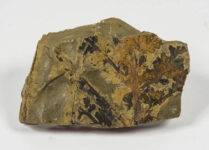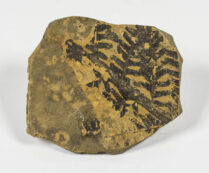Description
Cretaceous Ginkgo sp.
Late Cretaceous
Hell Creek Formation
Fallon County, MT USA.
45mm x 41mm Ginkgo leaf on 72mm matrix.
Plant.
Ginkgo is both the genus and the common name (aka the maidenhair tree) for a tree that dates back to the Early Jurassic of Asia. It declined in diversity across the Cretaceous but survived into the Paleocene in North America and Europe. Its paleogeographic range became increasing restricted across the Cenozoic.
Ginkgo died out in North America in the Late Miocene. It was still common in Europe during the Pliocene but died out there by the Pleistocene – an apparent victim of sharply cooling climates, the beginning of the ice ages.
Ginkgo was discovered alive in China about 900 years ago. It has been successfully reintroduced in Europe and North America as a popular ornamental tree known for its distinctive , fan-shaped leaves and its knack for being both fungus-resistanct and insect-resistant.
Bonus Natural Canvas Fun Fact: There are Ginkgo trees down my street.





